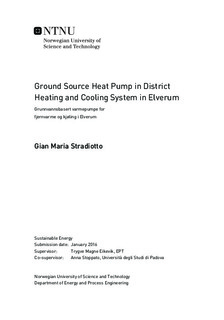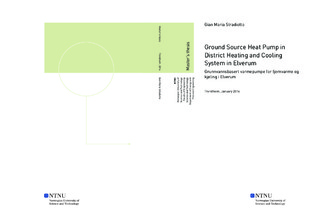| dc.description.abstract | The project presented in this master thesis work was evaluated from September 2015 -
January 2016 under the supervision of Professor Trygve Magne Eikevik , Department of
Energy and Process Engineering at the Norwegian University of Science and
Technology, in collaboration with the Project Manager Randi Kalskin Ramstad,
Department of Geology and Mineral Resources Engineering at the Norwegian University
of Science and Technology.
The paper is divided into seven main chapters as follows:
Chapter 1 is a general introduction to the project.
Chapter 2 provides a quick summary of the origin of the geothermal energy with some
historical data.
Chapter 3 reviews the actual state of the art regarding the Geothermal Heat Pumps, by
providing a rapid overview of all the technologies (Surface Water Heat Pumps, Ground
Water Heat Pumps and Ground Coupled Heat Pumps) and their possible applications.
Chapter 4 gives the reader some general data regarding the various typologies of heat
exchangers that are used in these kind of applications.
Chapter 5 provides a quick overview of the legislation regarding the refrigerants and an
introduction to some possible refrigerants that could be used during the heat pump cycle
(according to the legislation), with some economic data related to heat pumps operated
with those refrigerants.
Chapter 6 is the main chapter constituting the project itself. After a quick presentation of the main assumptions taken in this paper, the building site is analyzed using the planimetry and a system to fulfil the space heating/cooling and domestic hot water is designed (heat pumps and pipes). Afterwards the peak and simultaneous loads for each typology of building are evaluated to choose the shape of the distribution circuits; those in this paper are named circuit A for houses and row-houses and circuit B for all the other buildings. A first simple economical evaluation of the proposed heat pumps is then shown. In this chapter the needed electric heating to fulfil the peak load in each domiciles are also evaluated, after having chosen the dimension of the system, and the losses along the pipe network; in particular, adding the last ones to the chosen size of thesystem, the required size for the heat pump in each circuit was obtained, i.e. 131.56kW for circuit A and 726.30kW for circuit B. With these data , a simple economical evaluation was completed, using known information from the company Johnson Controls ,obtaining, with the chosen sizes and the chosen limits to the economic evaluation, a simple payback period of 8.760 and 8.068 years respectively for circuit A and B. In the end, with data regarding some heat-packs furnished by Johnson Controls , a simulation of the heat pump systems was operated using EES to confirm that what was hypothesized is achievable in the reality and to see how some parameters changes with the decrease of the load. The results of the simulation show that the size of the intermediate heat exchanger between the brine and the groundwater is 36.31m2 for the heat-pack of circuit A and 102.4m2 for each of the two heat-pack of circuit B and that the size of the heat exchangers to produce the domestic hot water and the space heating water, in circuit B during the summer mode at full load, is 2.853m2. The mass flow rates(kg/s) of the brine and of the groundwater for the two circuits during the winter and the summer modes were also found. After this some simulations were run at a partial load only with the purpose to see how the COP varies.
Chapter 7 contains the conclusions and some suggestions for future works on the site
and how the quality of the data to build the system could be improved.
After the list of the sources used to write this paper, the reader will find the appendix,containing some useful information discussed during the work. | |

